seats LEXUS RC350 2021 Owners Manual
[x] Cancel search | Manufacturer: LEXUS, Model Year: 2021, Model line: RC350, Model: LEXUS RC350 2021Pages: 400, PDF Size: 7.9 MB
Page 1 of 400
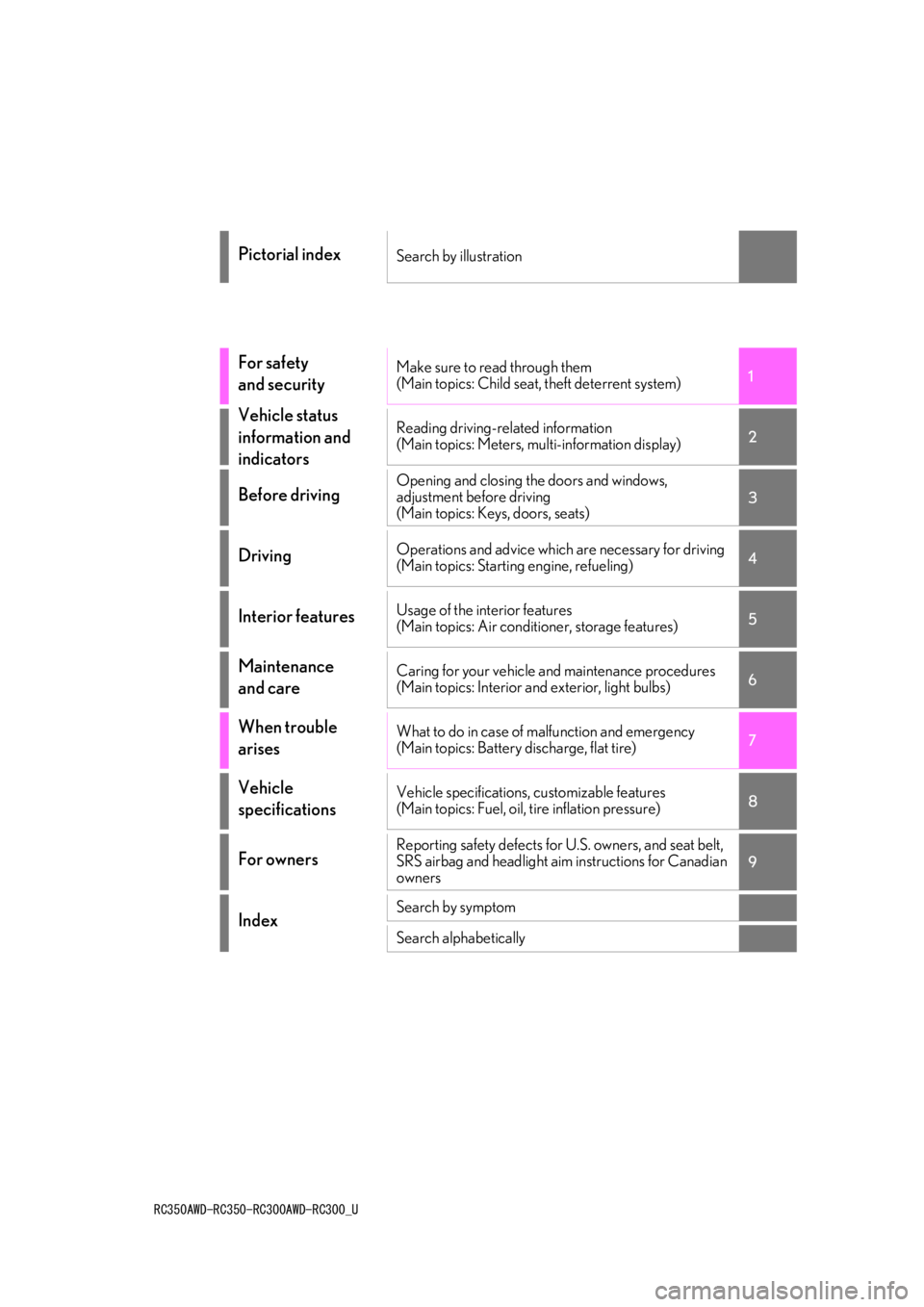
RC350AWD-RC350-RC300AWD-RC300_U
1
2
3
4
5
6
7
8
9
Pictorial indexSearch by illustration
For safety
and securityMake sure to read through them
(Main topics: Child seat, theft deterrent system)
Vehicle status
information and
indicatorsReading driving-related information
(Main topics: Meters, multi-information display)
Before drivingOpening and closing the doors and windows,
adjustment before driving
(Main topics: Keys, doors, seats)
DrivingOperations and advice which are necessary for driving
(Main topics: Starting engine, refueling)
Interior featuresUsage of the interior features
(Main topics: Air conditioner, storage features)
Maintenance
and careCaring for your vehicle and maintenance procedures
(Main topics: Interior and exterior, light bulbs)
When trouble
arisesWhat to do in case of malfunction and emergency
(Main topics: Battery discharge, flat tire)
Vehicle
specificationsVehicle specifications, customizable features
(Main topics: Fuel, oil, tire inflation pressure)
For ownersReporting safety defects for U.S. owners, and seat belt,
SRS airbag and headlight aim instructions for Canadian
owners
IndexSearch by symptom
Search alphabetically
Page 2 of 400

2TABLE OF CONTENTS
For your information ......................................5
Reading this manual ....................................... 9
How to search ............................................... 10
Pictorial index .................................................. 11
1-1. For safe use Before driving .................................... 22
For safe driving.................................. 23
Seat belts ............................................. 24
SRS airbags ....................................... 28
Front passenger occupant classifi- cation system ................................. 36
Riding with children........................ 40
Child restraint systems ................. 40
Exhaust gas precautions ................ 51
1-2. LEXUS Enform Lexus Enform Safety Connect ... 52
1-3. Theft deterrent system Engine immobilizer system ......... 56
Alarm.................................................... 57
Theft prevention labels (U.S.A.) .............................................................. 59
2-1. Instrument cluster Warning lights and indicators ..... 62
Gauges and meters ....................... 66
Multi-information display............... 71
Fuel consumption information ... 793-1. Key information
Keys ....................................................... 84
3-2. Opening, closing and locking the doors and trunk
Doors ................................................... 88
Trunk ...................................................... 91
Smart access system with push-but- ton start ............................................. 95
3-3. Adjusting the seats Front seats........................................... 99
Rear seats.......................................... 101
Power easy access system/driving position memory/memory recall
function........................................... 102
Head restraints .............................. 105
3-4. Adjusting the steering wheel and mirrors
Steering wheel ............................... 108
Inside rear view mirror ............... 109
Outside rear view mirrors.......... 110
3-5. Opening, closing the windows and moon roof
Power windows ............................... 112
Moon roof .......................................... 114
4-1. Before driving Driving the vehicle......................... 118
Cargo and luggage....................... 123
Vehicle load limits.......................... 125
Trailer towing................................... 126
Dinghy towing ................................. 126
1For safety and security
2Vehicle status information and
indicators
3Before driving
4Driving
Page 18 of 400
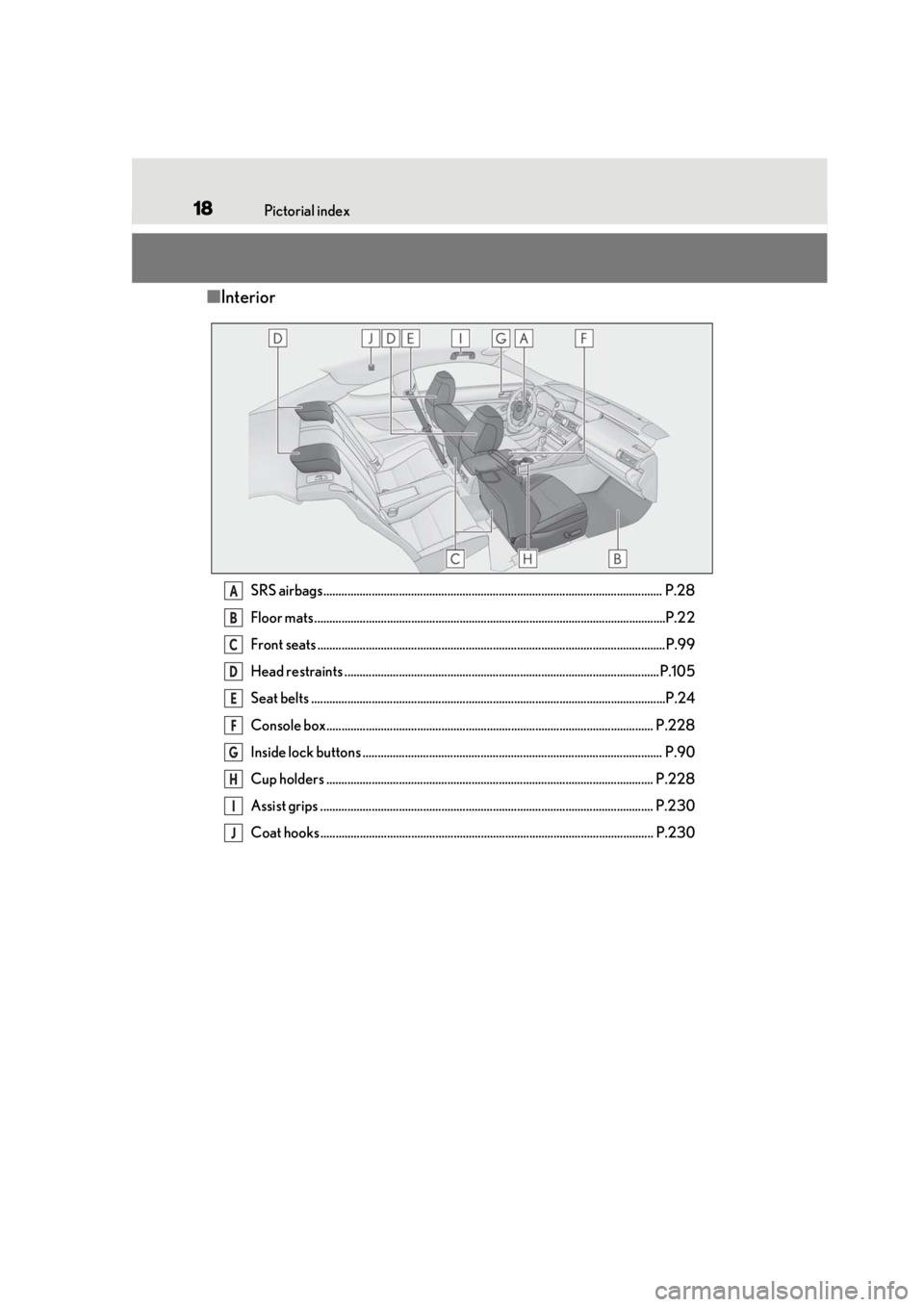
18Pictorial index
■Interior
SRS airbags................................................................................................................ P.28
Floor mats ....................................................................................................................P .22
Front seats ...................................................................................................................P .99
Head restraints ........................................................................................................P.105
Seat belts ..................................................................................................................... P.24
Console box............................................................................................................ P.228
Inside lock buttons ................................................................................................... P.90
Cup holders ............................................................................................................ P.228
Assist grips .............................................................................................................. P.230
Coat hooks .............................................................................................................. P.230A
B
C
D
E
F
G
H
I
J
Page 23 of 400
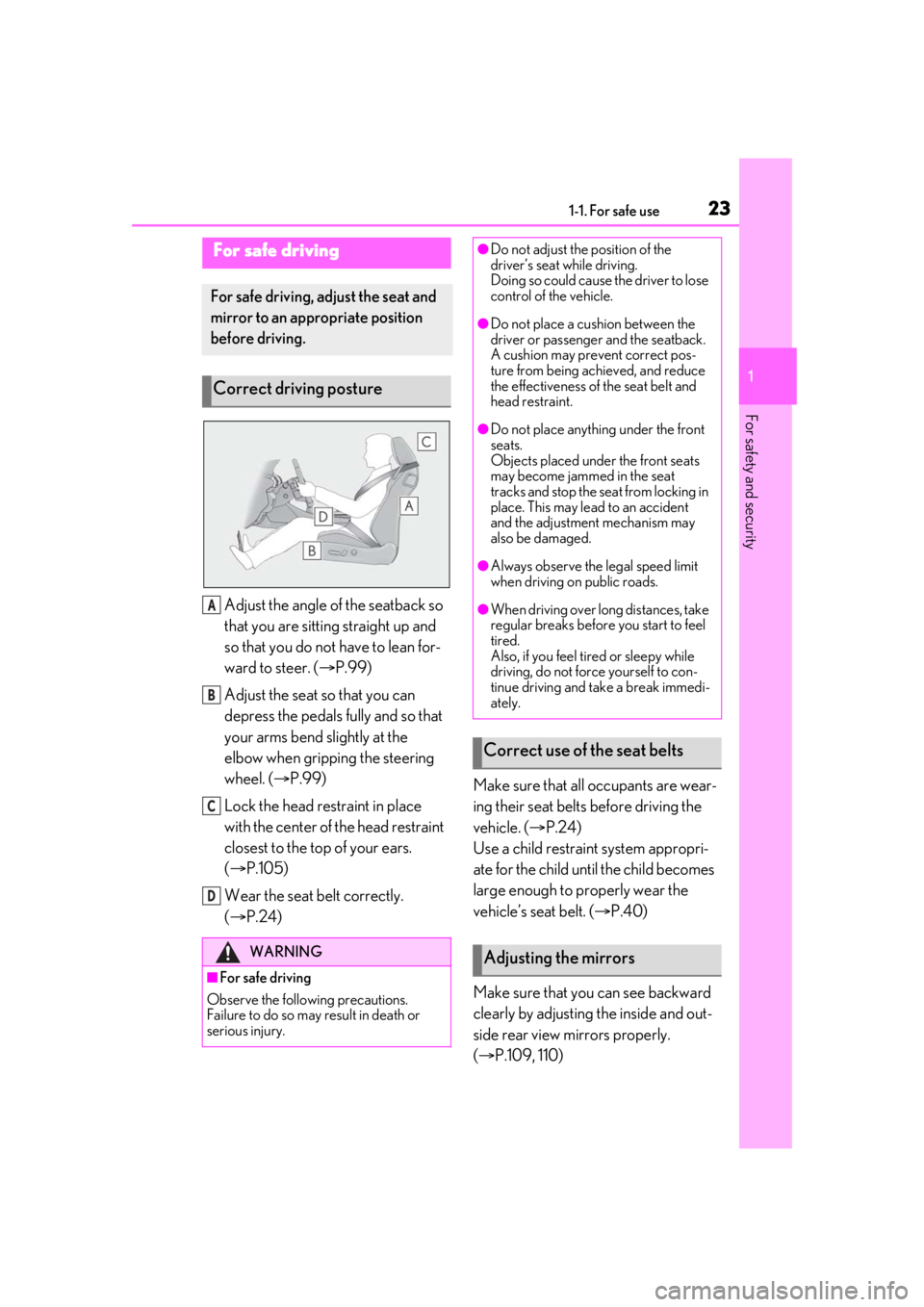
231-1. For safe use
1
For safety and security
Adjust the angle of the seatback so
that you are sitting straight up and
so that you do not have to lean for-
ward to steer. (P.99)
Adjust the seat so that you can
depress the pedals fully and so that
your arms bend slightly at the
elbow when gripping the steering
wheel. ( P.99)
Lock the head restraint in place
with the center of the head restraint
closest to the top of your ears.
( P.105)
Wear the seat belt correctly.
( P.24) Make sure that all occupants are wear-
ing their seat belts before driving the
vehicle. (
P.24)
Use a child restraint system appropri-
ate for the child until the child becomes
large enough to properly wear the
vehicle’s seat belt. ( P.40)
Make sure that you can see backward
clearly by adjusting the inside and out-
side rear view mirrors properly.
( P.109, 110)
For safe driving
For safe driving, adjust the seat and
mirror to an appropriate position
before driving.
Correct driving posture
WARNING
■For safe driving
Observe the following precautions.
Failure to do so may result in death or
serious injury.
A
B
C
D
●Do not adjust the position of the
driver’s seat while driving.
Doing so could cause the driver to lose
control of the vehicle.
●Do not place a cushion between the
driver or passenger and the seatback.
A cushion may prevent correct pos-
ture from being achieved, and reduce
the effectiveness of the seat belt and
head restraint.
●Do not place anything under the front
seats.
Objects placed under the front seats
may become jammed in the seat
tracks and stop the seat from locking in
place. This may lead to an accident
and the adjustment mechanism may
also be damaged.
●Always observe the legal speed limit
when driving on public roads.
●When driving over long distances, take
regular breaks before you start to feel
tired.
Also, if you feel tired or sleepy while
driving, do not force yourself to con-
tinue driving and take a break immedi-
ately.
Correct use of the seat belts
Adjusting the mirrors
Page 24 of 400
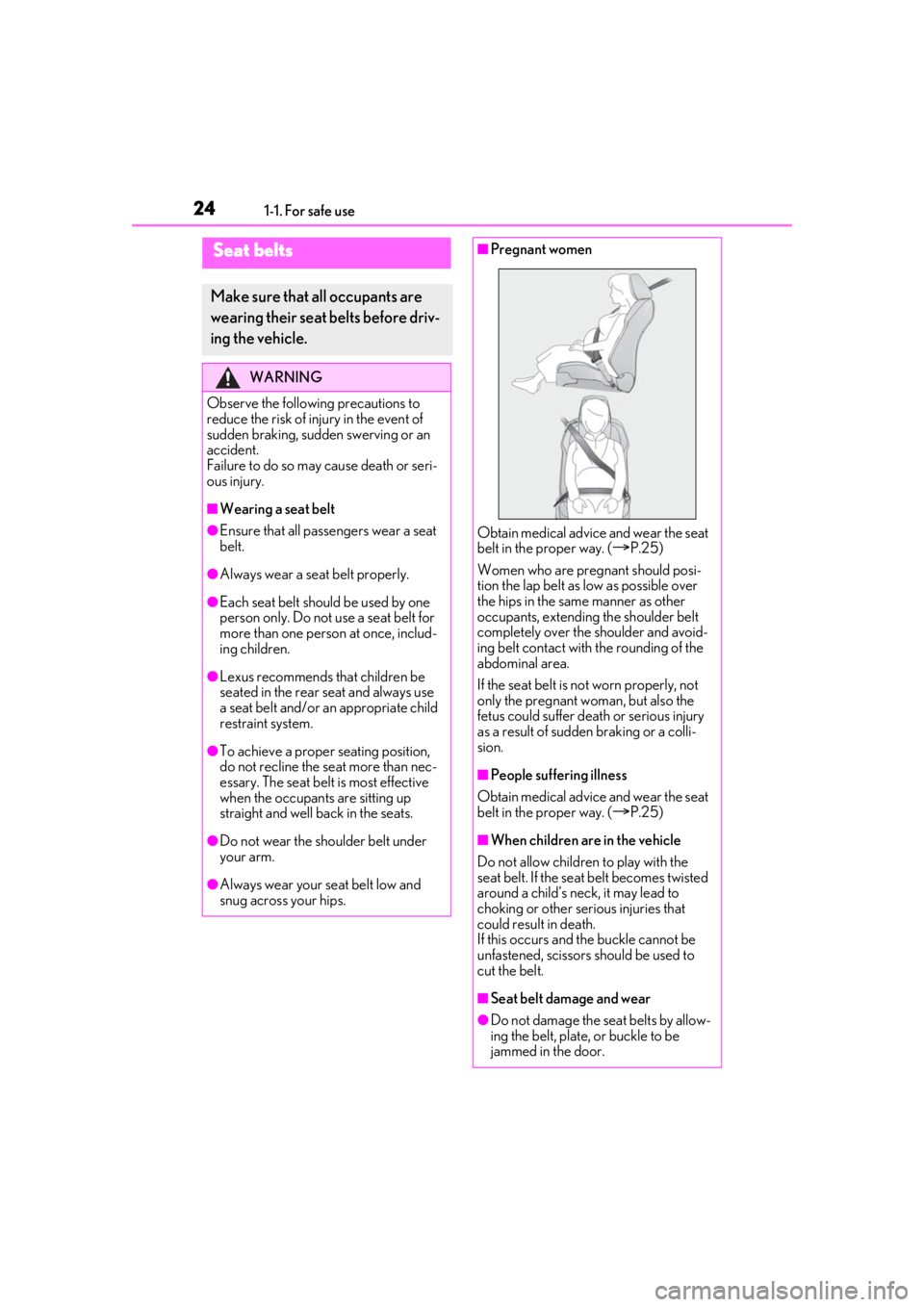
241-1. For safe use
Seat belts
Make sure that all occupants are
wearing their seat belts before driv-
ing the vehicle.
WARNING
Observe the following precautions to
reduce the risk of injury in the event of
sudden braking, sudden swerving or an
accident.
Failure to do so may cause death or seri-
ous injury.
■Wearing a seat belt
●Ensure that all passengers wear a seat
belt.
●Always wear a seat belt properly.
●Each seat belt should be used by one
person only. Do not use a seat belt for
more than one person at once, includ-
ing children.
●Lexus recommends that children be
seated in the rear seat and always use
a seat belt and/or an appropriate child
restraint system.
●To achieve a proper seating position,
do not recline the seat more than nec-
essary. The seat belt is most effective
when the occupants are sitting up
straight and well back in the seats.
●Do not wear the shoulder belt under
your arm.
●Always wear your seat belt low and
snug across your hips.
■Pregnant women
Obtain medical advice and wear the seat
belt in the proper way. (
P.25)
Women who are pregnant should posi-
tion the lap belt as low as possible over
the hips in the same manner as other
occupants, extending the shoulder belt
completely over the shoulder and avoid-
ing belt contact with the rounding of the
abdominal area.
If the seat belt is not worn properly, not
only the pregnant woman, but also the
fetus could suffer death or serious injury
as a result of sudden braking or a colli-
sion.
■People suffering illness
Obtain medical advice and wear the seat
belt in the proper way. (
P.25)
■When children are in the vehicle
Do not allow children to play with the
seat belt. If the seat belt becomes twisted
around a child’s neck, it may lead to
choking or other serious injuries that
could result in death.
If this occurs and the buckle cannot be
unfastened, scissors should be used to
cut the belt.
■Seat belt damage and wear
●Do not damage the seat belts by allow-
ing the belt, plate, or buckle to be
jammed in the door.
Page 26 of 400
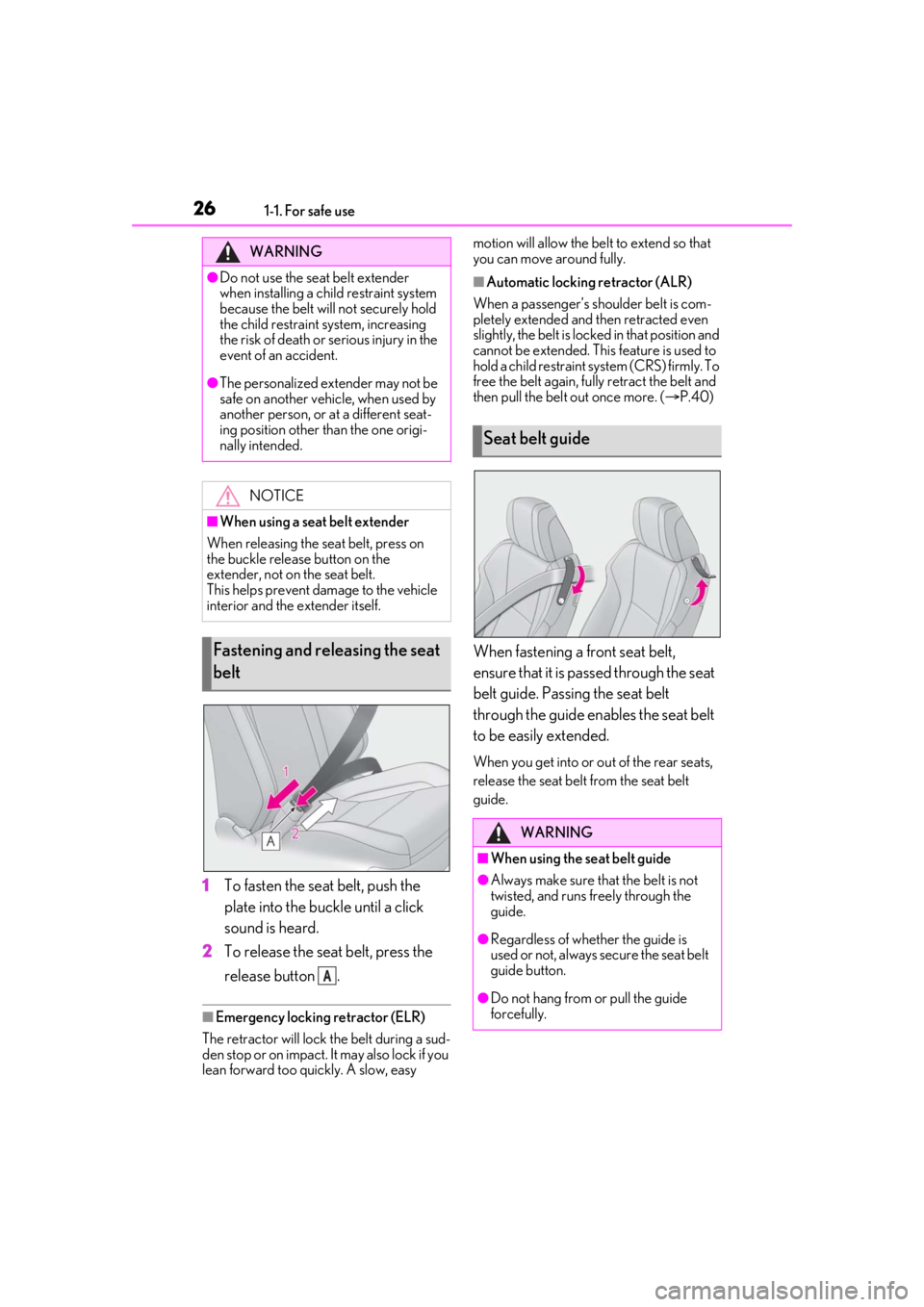
261-1. For safe use
1To fasten the seat belt, push the
plate into the buckle until a click
sound is heard.
2 To release the seat belt, press the
release button .
■Emergency locking retractor (ELR)
The retractor will lock the belt during a sud-
den stop or on impact. It may also lock if you
lean forward too quickly. A slow, easy motion will allow the belt to extend so that
you can move around fully.
■Automatic locking retractor (ALR)
When a passenger’s shoulder belt is com-
pletely extended and then retracted even
slightly, the belt is lock ed in that position and
cannot be extended. This feature is used to
hold a child restraint system (CRS) firmly. To
free the belt again, fu lly retract the belt and
then pull the belt out once more. ( P.40)
When fastening a front seat belt,
ensure that it is passed through the seat
belt guide. Passing the seat belt
through the guide enables the seat belt
to be easily extended.
When you get into or ou t of the rear seats,
release the seat belt from the seat belt
guide.
WARNING
●Do not use the seat belt extender
when installing a child restraint system
because the belt will not securely hold
the child restraint system, increasing
the risk of death or serious injury in the
event of an accident.
●The personalized extender may not be
safe on another vehicle, when used by
another person, or at a different seat-
ing position other than the one origi-
nally intended.
NOTICE
■When using a seat belt extender
When releasing the se at belt, press on
the buckle release button on the
extender, not on the seat belt.
This helps prevent damage to the vehicle
interior and the extender itself.
Fastening and releasing the seat
belt
A
Seat belt guide
WARNING
■When using the seat belt guide
●Always make sure that the belt is not
twisted, and runs freely through the
guide.
●Regardless of whether the guide is
used or not, always secure the seat belt
guide button.
●Do not hang from or pull the guide
forcefully.
Page 28 of 400

281-1. For safe use
■Location of the SRS airbags
SRS front airbagsSRS driver airbag/front passenger airbag
Can help protect the head and chest of the driver and front passenger from impact with
interior components
SRS knee airbags
Can help provide driver and front passenger protection
SRS side and curtain shield airbagsSRS side airbags
Can help protect the torso of the front seat occupants
SRS curtain shield airbags
• Can help protect primarily the head of occupants in the outer seats
• Can help prevent the occupants from being thrown from the vehicle in the event of vehi-
SRS airbags
The SRS airbags inflate when the vehicle is subjected to certain types of severe
impacts that may cause significant injury to the occupants. They work together
with the seat belts to help reduce the risk of death or serious injury.
SRS airbag system
A
B
C
D
Page 32 of 400

321-1. For safe use
■When to contact your Lexus dealer
In the following cases, the vehicle will
require inspection and/or repair. Contact
your Lexus dealer as soon as possible.
●Any of the SRS airbags have been
inflated.
●The front of the vehicle is damaged or
deformed, or was involved in an accident
that was not severe enough to cause the
SRS front airbags to inflate.
●A portion of a door or its surrounding
area is damaged or deformed, or the
vehicle was involved in an accident that
was not severe enough to cause the SRS
side and curtain shield airbags to inflate.
●The pad section of the steering wheel,
dashboard near the front passenger air-
bag or lower portion of the instrument
panel is scratched, cracked, or otherwise
damaged.
●The surface of the seats with the SRS side
airbag is scratched, cracked, or other-
wise damaged.
●The portion of the front pillars, rear pillars
or roof side rail ga rnishes (padding) con-
taining the SRS curtain shield airbags
inside is scratched, cracked, or otherwise
damaged.
WARNING
■SRS airbag precautions
Observe the following precautions
regarding the SRS airb ags. Failure to do
so may cause death or serious injury.
●The driver and all passengers in the
vehicle must wear their seat belts
properly.
The SRS airbags are supplemental
devices to be used with the seat belts.
Page 33 of 400
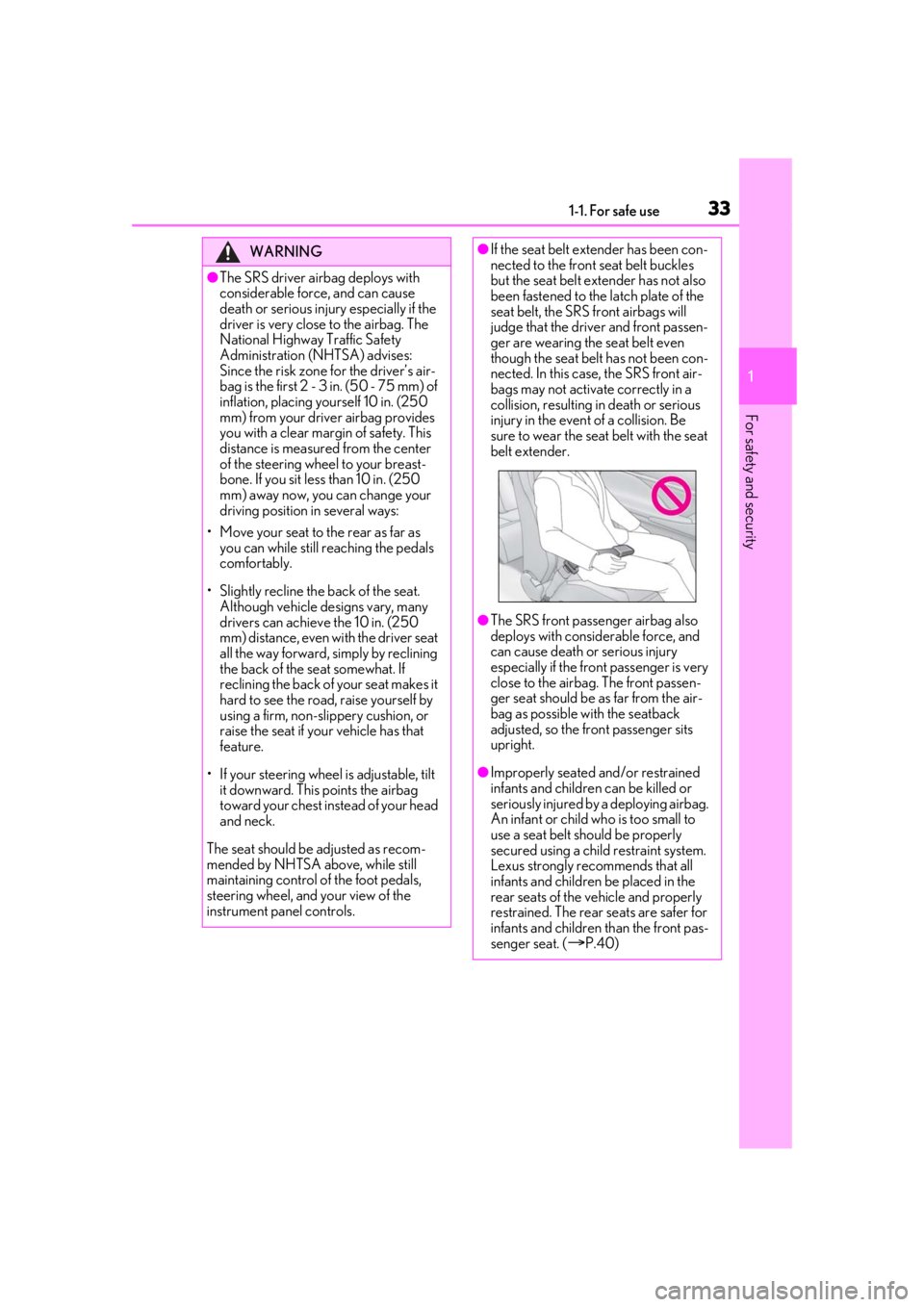
331-1. For safe use
1
For safety and security
WARNING
●The SRS driver airbag deploys with
considerable force, and can cause
death or serious injury especially if the
driver is very close to the airbag. The
National Highway Traffic Safety
Administration (NHTSA) advises:
Since the risk zone for the driver’s air-
bag is the first 2 - 3 in. (50 - 75 mm) of
inflation, placing yourself 10 in. (250
mm) from your driver airbag provides
you with a clear margin of safety. This
distance is measured from the center
of the steering wheel to your breast-
bone. If you sit less than 10 in. (250
mm) away now, you can change your
driving position in several ways:
• Move your seat to the rear as far as you can while still reaching the pedals
comfortably.
• Slightly recline the back of the seat. Although vehicle designs vary, many
drivers can achieve the 10 in. (250
mm) distance, even with the driver seat
all the way forward, simply by reclining
the back of the se at somewhat. If
reclining the back of your seat makes it
hard to see the road, raise yourself by
using a firm, non-slippery cushion, or
raise the seat if your vehicle has that
feature.
• If your steering wheel is adjustable, tilt it downward. This points the airbag
toward your chest instead of your head
and neck.
The seat should be adjusted as recom-
mended by NHTSA above, while still
maintaining control of the foot pedals,
steering wheel, and your view of the
instrument panel controls.
●If the seat belt extender has been con-
nected to the front seat belt buckles
but the seat belt extender has not also
been fastened to the latch plate of the
seat belt, the SRS front airbags will
judge that the driver and front passen-
ger are wearing the seat belt even
though the seat belt has not been con-
nected. In this case, the SRS front air-
bags may not activate correctly in a
collision, resulting in death or serious
injury in the event of a collision. Be
sure to wear the seat belt with the seat
belt extender.
●The SRS front passenger airbag also
deploys with considerable force, and
can cause death or serious injury
especially if the front passenger is very
close to the airbag. The front passen-
ger seat should be as far from the air-
bag as possible with the seatback
adjusted, so the front passenger sits
upright.
●Improperly seated and/or restrained
infants and children can be killed or
seriously injured by a deploying airbag.
An infant or child who is too small to
use a seat belt should be properly
secured using a child restraint system.
Lexus strongly recommends that all
infants and children be placed in the
rear seats of the vehicle and properly
restrained. The rear seats are safer for
infants and children than the front pas-
senger seat. (
P.40)
Page 34 of 400

341-1. For safe use
WARNING
●Do not sit on the edge of the seat or
lean against the dashboard.
●Do not allow a child to stand in front of
the SRS front passenger airbag unit or
sit on the knees of a front passenger.
●Do not allow the front seat occupants
to hold items on their knees.
●Do not lean against the door, the roof
side rail or the front, side and rear pil-
lars.
●Do not allow anyone to kneel on the
passenger seats toward the door or
put their head or hands outside the
vehicle.
●Do not attach anything to or lean any-
thing against areas such as the dash-
board, steering wheel pad and lower
portion of the instrument panel.
These items can become projectiles
when the SRS driver, front passenger
and knee airbags deploy.
●Do not attach anything to areas such
as a door, windshield, side windshield,
front or rear pillar, roof side rail and
assist grip.
●Do not hang coat hangers or hard
objects on the coat hooks. All of these
items could become projectiles and
may cause death or serious injury,
should the SRS curtain shield airbags
deploy.